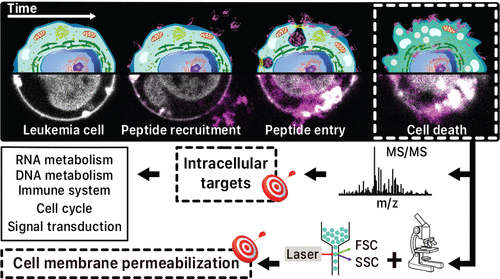当前位置:
X-MOL 学术
›
ACS Chem. Biol.
›
论文详情
Our official English website, www.x-mol.net, welcomes your feedback! (Note: you will need to create a separate account there.)
Tumor Cell Attack by Crotalicidin (Ctn) and Its Fragment Ctn[15–34]: Insights into Their Dual Membranolytic and Intracellular Targeting Mechanism
ACS Chemical Biology ( IF 4 ) Pub Date : 2020-10-06 , DOI: 10.1021/acschembio.0c00596 Clara Pérez-Peinado 1 , Javier Valle 1 , João M. Freire 2 , David Andreu 1
ACS Chemical Biology ( IF 4 ) Pub Date : 2020-10-06 , DOI: 10.1021/acschembio.0c00596 Clara Pérez-Peinado 1 , Javier Valle 1 , João M. Freire 2 , David Andreu 1
Affiliation

|
Crotalicidin (Ctn) and its fragment Ctn[15–34] are snake-venom-derived, cathelicidin-related peptides outstanding for their promising antimicrobial, antifungal, and antitumoral properties. In this study, we describe their membranolytic mechanisms as well as their putative interference with intracellular targets, both contributing to their antitumoral action against a pro-monocytic leukemia cell line. Initial flow cytometry assays demonstrated peptide ability to induce tumor cell membrane permeabilization and caspase-dependent apoptosis, without total activity reduction by serum proteases up to 24 h (Ctn) and 18 h (Ctn[15–34]). In addition, both Ctn and Ctn[15–34] showed preference for tumor cells rather than healthy cells, with selectivity ratios (tumoral vs healthy cells) of 17 and 7, respectively. Further microscopy and flow cytometry studies suggested their preferential accumulation in the cytoplasmic membrane and nucleus and proposed multiple predominant routes of peptide uptake, including direct entry and endocytosis. Affinity purification followed by proteomic identification experiments revealed both peptides to interact with proteins involved in DNA and protein metabolism, cell cycles, signal transduction, and/or programmed cell death, among others. These results suggest a putative role of Ctn and Ctn[15–34] to interact with key intracellular pathways, ultimately contributing to tumor cell death by necrosis/apoptosis. Altogether, this work proposes a dual mechanism underlying the antitumoral activity of Ctn and Ctn[15–34] and reinforces their potential as future therapeutic drugs.
中文翻译:

Crotalicidin(Ctn)及其片段Ctn [15–34]对肿瘤细胞的攻击:深入了解其双重膜溶解和细胞内靶向机制
Crotalicidin(Ctn)及其片段Ctn [15-34]是蛇毒衍生的,与Cathelicidin相关的肽,具有出色的抗微生物,抗真菌和抗肿瘤特性。在这项研究中,我们描述了它们的膜分解机制以及对细胞内靶标的推定干扰,两者均有助于它们对单核细胞白血病细胞系的抗肿瘤作用。最初的流式细胞仪分析表明,肽具有诱导肿瘤细胞膜通透性和caspase依赖性细胞凋亡的能力,在长达24 h(Ctn)和18 h(Ctn [15–34])时,血清蛋白酶不会降低总活性。此外,Ctn和Ctn [15-34]均显示出对肿瘤细胞而非健康细胞的偏爱,其选择性比(肿瘤细胞与健康细胞)分别为17和7。进一步的显微镜和流式细胞术研究表明它们优先积累在细胞质膜和细胞核中,并提出了多种主要的肽摄取途径,包括直接进入和胞吞作用。亲和纯化,然后进行蛋白质组学鉴定实验,发现这两种肽均可与参与DNA和蛋白质代谢,细胞周期,信号转导和/或程序性细胞死亡等的蛋白质相互作用。这些结果表明,Ctn和Ctn [15-34]可能与关键的细胞内途径相互作用,最终导致肿瘤细胞因坏死/凋亡而死亡。总之,这项工作提出了Ctn和Ctn [15-34]的抗肿瘤活性的双重机制,并增强了它们作为未来治疗药物的潜力。
更新日期:2020-11-21
中文翻译:

Crotalicidin(Ctn)及其片段Ctn [15–34]对肿瘤细胞的攻击:深入了解其双重膜溶解和细胞内靶向机制
Crotalicidin(Ctn)及其片段Ctn [15-34]是蛇毒衍生的,与Cathelicidin相关的肽,具有出色的抗微生物,抗真菌和抗肿瘤特性。在这项研究中,我们描述了它们的膜分解机制以及对细胞内靶标的推定干扰,两者均有助于它们对单核细胞白血病细胞系的抗肿瘤作用。最初的流式细胞仪分析表明,肽具有诱导肿瘤细胞膜通透性和caspase依赖性细胞凋亡的能力,在长达24 h(Ctn)和18 h(Ctn [15–34])时,血清蛋白酶不会降低总活性。此外,Ctn和Ctn [15-34]均显示出对肿瘤细胞而非健康细胞的偏爱,其选择性比(肿瘤细胞与健康细胞)分别为17和7。进一步的显微镜和流式细胞术研究表明它们优先积累在细胞质膜和细胞核中,并提出了多种主要的肽摄取途径,包括直接进入和胞吞作用。亲和纯化,然后进行蛋白质组学鉴定实验,发现这两种肽均可与参与DNA和蛋白质代谢,细胞周期,信号转导和/或程序性细胞死亡等的蛋白质相互作用。这些结果表明,Ctn和Ctn [15-34]可能与关键的细胞内途径相互作用,最终导致肿瘤细胞因坏死/凋亡而死亡。总之,这项工作提出了Ctn和Ctn [15-34]的抗肿瘤活性的双重机制,并增强了它们作为未来治疗药物的潜力。


























 京公网安备 11010802027423号
京公网安备 11010802027423号